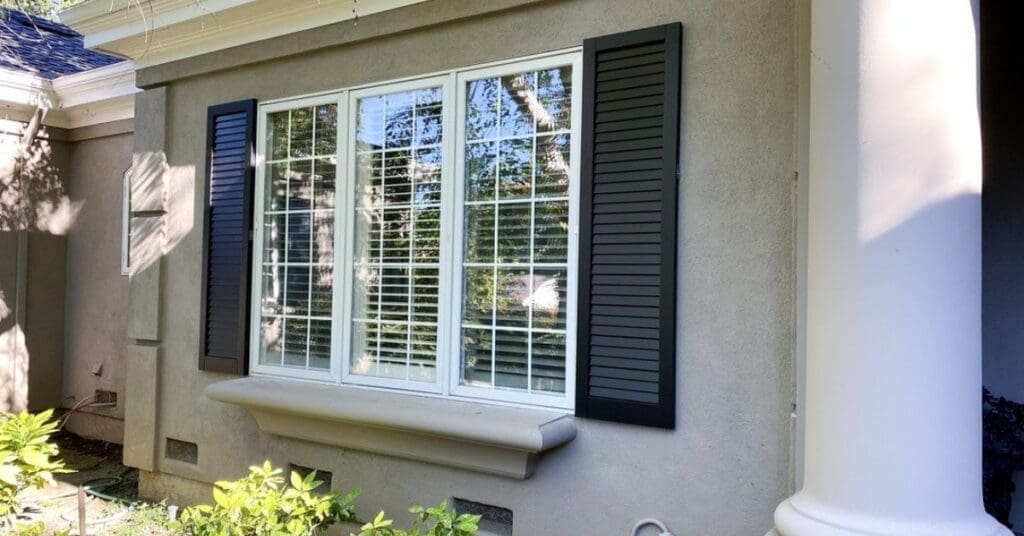Exterior shutters elevate your home’s curb appeal and provide valuable protection and insulation. Like any part of your home, they require regular maintenance to preserve their appearance and functionality.
Use this seasonal maintenance checklist for exterior shutters to keep them in excellent condition throughout the year. Whether you’re tackling the task yourself or hiring a contractor, these practical steps will extend the life of your shutters and prevent costly repairs down the road.
Clean Shutters Thoroughly
Keeping your shutters clean is essential to maintaining their appearance and ensuring long-term durability. Use a soft-bristle brush or cloth to gently remove dirt, dust, and cobwebs from the shutters’ surface. For a deeper clean, wash the shutters using warm, soapy water and rinse them with a garden hose.
Avoid high-pressure washing, as it may damage the finish or loosen any hardware. Pay special attention to the corners and crevices where grime tends to accumulate.
Inspect for Damage
A thorough inspection allows you to identify problems before they worsen. Inspect wooden shutters for cracks, splinters, or warping, especially if they’re exterior cedar shutters, which require routine care to preserve their natural beauty. Check your vinyl or composite shutters for dents, scratches, or any signs of wear if you have them.
Inspect the edges and mounting points closely, as these areas are prone to damage. Document any issues you find and promptly address them to prevent further deterioration. A quick inspection each season is an easy way to protect your investment.
Examine Hardware
The hardware holding your shutters in place is just as important as the shutters themselves. Properly maintained hardware supports the structure of the shutters and prevents mounting failures, especially during heavy winds or storms.
Check for loose screws, brackets, or hinges, and tighten them as needed to ensure your shutters remain securely in place. Apply a rust-resistant lubricant if you notice rust or wear on metal hinges to keep them functioning smoothly. Ensure your shutters with functional hardware, such as operable louvers or hinges, open and close without difficulty.
Touch Up Paint or Finish

Over time, exposure to the elements causes paint to fade or crack, diminishing your shutters’ visual appeal. Consistently maintaining the finish enhances the shutters’ appearance while providing a protective barrier against moisture and UV damage.
Start by filling any cracks or chips in your wood shutters with wood filler and sanding the surface until it’s smooth. Follow up by repainting or re-staining the shutters using a premium-quality, weather-resistant product. Touch up faded or scratched areas in your vinyl shutters with paint that matches the original finish.
Seal Wooden Shutters
Wooden shutters are particularly vulnerable to moisture and sun exposure. Applying a fresh coat of sealant each year protects the wood from rot, warping, and other damage caused by extreme weather conditions. Ensure the shutters are clean and dry before sealing, and sand any rough patches to achieve a smooth application.
Use a high-quality outdoor wood sealant specifically designed for UV and water resistance to achieve the best results. This step is especially important before wet or humid seasons to prevent long-term issues and preserve your wooden shutters’ natural appeal.
Clear Surrounding Areas
Vegetation that grows too close to your shutters may cause scratches, stains, and even pest infestations. Your seasonal maintenance checklist for exterior shutters should include their removal to prevent them from growing around the structures. Trim back bushes, trees, or vines that are within proximity to the shutters to prevent direct contact. Ensure that the surrounding area is well-ventilated, as proper airflow reduces the risk of mold or mildew.
Additionally, remove leaves, twigs, and other debris that may accumulate on or around the shutters in the fall. Keeping the area clear ensures your shutters remain pristine and reduces the likelihood of environmental damage.
Check for Mold or Mildew
Mold and mildew often develop on shutters, particularly after periods of rainy or humid weather. Inspect your shutters for any signs of discoloration or growth, paying close attention to shaded areas where moisture tends to linger. Create a cleaning solution using equal parts vinegar and water if you spot any mold or mildew.
Apply the solution with a soft cloth or sponge, gently scrubbing to remove the growth. Rinse thoroughly and allow the shutters to dry completely before sealing or painting. Regularly addressing mold and mildew protects your shutters’ appearance and integrity.
Prepare for Harsh Weather
Extreme weather conditions take a toll on your shutters, so it’s wise to prepare them in advance. Install storm hooks or additional fasteners to keep shutters securely in place during strong winds or heavy snow. Consider removing and storing your more vulnerable, decorative or lightweight shutters indoors during severe winters if you have them.
Check that your shutters are properly mounted and reinforced to handle seasonal challenges. Proactive preparation reduces the likelihood of weather-related damage and helps you avoid unexpected repairs.
Maintain Color and Appearance

Exposure to sunlight causes shutters to fade over time, diminishing their appearance. Prioritizing the appearance of your shutters boosts curb appeal and protects their surface from long-term wear. Applying a UV-protectant spray can help your shutters resist sun damage and maintain their vibrant color.
It’s also a good idea to perform small touch-ups throughout the year to keep the finish looking fresh. Pay attention to areas that face direct sunlight, as they may require extra care.
Defend Against Snow and Ice Buildup
Snow and ice buildup place unnecessary strain on your shutters, potentially causing them to warp, crack, or loosen over time. Make it a habit to clear snow and ice from your shutters during the winter months to prevent damage. Use a soft brush or cloth to gently remove the buildup, avoiding sharp tools that might damage the surface.
Consider applying a protective coating designed to repel moisture, which can prevent ice from sticking to the shutters. Promptly address snow and ice buildup to extend your shutters’ lifespan and keep them in excellent condition throughout the colder seasons.
Inspect the Caulking Around Shutters
Over time, the caulking around your shutters wears down or cracks due to exposure to the elements. Inspect the areas where the shutters meet the wall to ensure the caulking remains intact and provides a proper seal. Damaged or missing caulking allows water to seep behind the shutters, potentially leading to moisture damage, mold growth, or structural deterioration.
Remove the old caulking and apply a fresh, weather-resistant sealant if you notice any cracks, gaps, or signs of wear. Regularly maintaining the caulking keeps your shutters securely attached and visually appealing.
Maintaining your exterior shutters doesn’t have to feel like a hassle. Follow this checklist to safeguard their longevity and keep them looking great through every season. Start your first inspection today and enjoy the benefits of shutters that enhance the beauty and functionality of your home!









